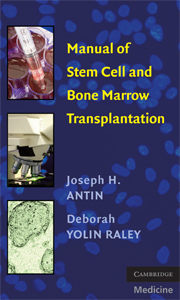Book contents
- Frontmatter
- Contents
- Acknowledgments
- Manual of Stem Cell and Bone Marrow Transplantation
- 1 Rationale for Transplantation
- 2 Types of Transplantation
- 3 HLA Matching in Allogeneic Transplantation
- 4 Stem Cell Source
- 5 Pretransplant Evaluation and Counseling of Patient and Donor
- 6 Conditioning Regimens
- 7 Stem Cell Infusion
- 8 ABO Compatibility
- 9 Engraftment
- 10 Preventative Care
- 11 Transplant-Related Complications
- 12 Graft-Versus-Host Disease – Prophylaxis and Acute
- 13 Graft-Versus-Host Disease – Chronic
- 14 Engraftment Syndrome
- 15 Infectious Disease
- 16 Graft Rejection And Failure
- 17 Gastrointestinal Complications
- 18 Pulmonary Complications
- 19 Veno-Occlusive Disease
- 20 Special Transfusion-Related Situations
- 21 Cardiovascular Complications
- 22 Neurologic Complications
- 23 Cystitis
- 24 Donor Lymphocyte Infusion
- 25 Transplantation: Regulation And Accreditation
- Appendix
- Index
22 - Neurologic Complications
Published online by Cambridge University Press: 23 November 2009
- Frontmatter
- Contents
- Acknowledgments
- Manual of Stem Cell and Bone Marrow Transplantation
- 1 Rationale for Transplantation
- 2 Types of Transplantation
- 3 HLA Matching in Allogeneic Transplantation
- 4 Stem Cell Source
- 5 Pretransplant Evaluation and Counseling of Patient and Donor
- 6 Conditioning Regimens
- 7 Stem Cell Infusion
- 8 ABO Compatibility
- 9 Engraftment
- 10 Preventative Care
- 11 Transplant-Related Complications
- 12 Graft-Versus-Host Disease – Prophylaxis and Acute
- 13 Graft-Versus-Host Disease – Chronic
- 14 Engraftment Syndrome
- 15 Infectious Disease
- 16 Graft Rejection And Failure
- 17 Gastrointestinal Complications
- 18 Pulmonary Complications
- 19 Veno-Occlusive Disease
- 20 Special Transfusion-Related Situations
- 21 Cardiovascular Complications
- 22 Neurologic Complications
- 23 Cystitis
- 24 Donor Lymphocyte Infusion
- 25 Transplantation: Regulation And Accreditation
- Appendix
- Index
Summary
Neurologic toxicity is common and often multifactorial. The primary causes of neurologic injury are (1) drug toxicity, (2) infection, (3) toxic metabolic encephalopathy, and (4) hemorrhage. It is convenient to consider neurologic injury occurring early after transplantation and that occurring late after transplantation separately. Early toxicity tends to be related to immediate problems with conditioning regimen effects. Preexistent neurological problems related to malignancy or metabolic encephalopathy are likely to increase the risk of immediate posttransplantation neurologic symptoms. Later events are often related to prolonged immunoincompetence and the effects of calcineurin inhibitors.
EARLY - POSTTRANSPLANT PERIOD
Calcineurin Inhibitors
The calcineurin inhibitors (CNI) cyclosporine and tacrolimus are probably the single most frequent cause of neurologic toxicity. The most common manifestations are tremor and burning palmar and plantar dysesthesias. However, headache, depression, confusion, somnolence, and nystagmus may be observed. Seizures may occur, especially in association with hypomagnesemia, hypertension, hypocholesterolemia, infections, and high blood levels of CNI.
[…]
- Type
- Chapter
- Information
- Manual of Stem Cell and Bone Marrow Transplantation , pp. 150 - 154Publisher: Cambridge University PressPrint publication year: 2009



